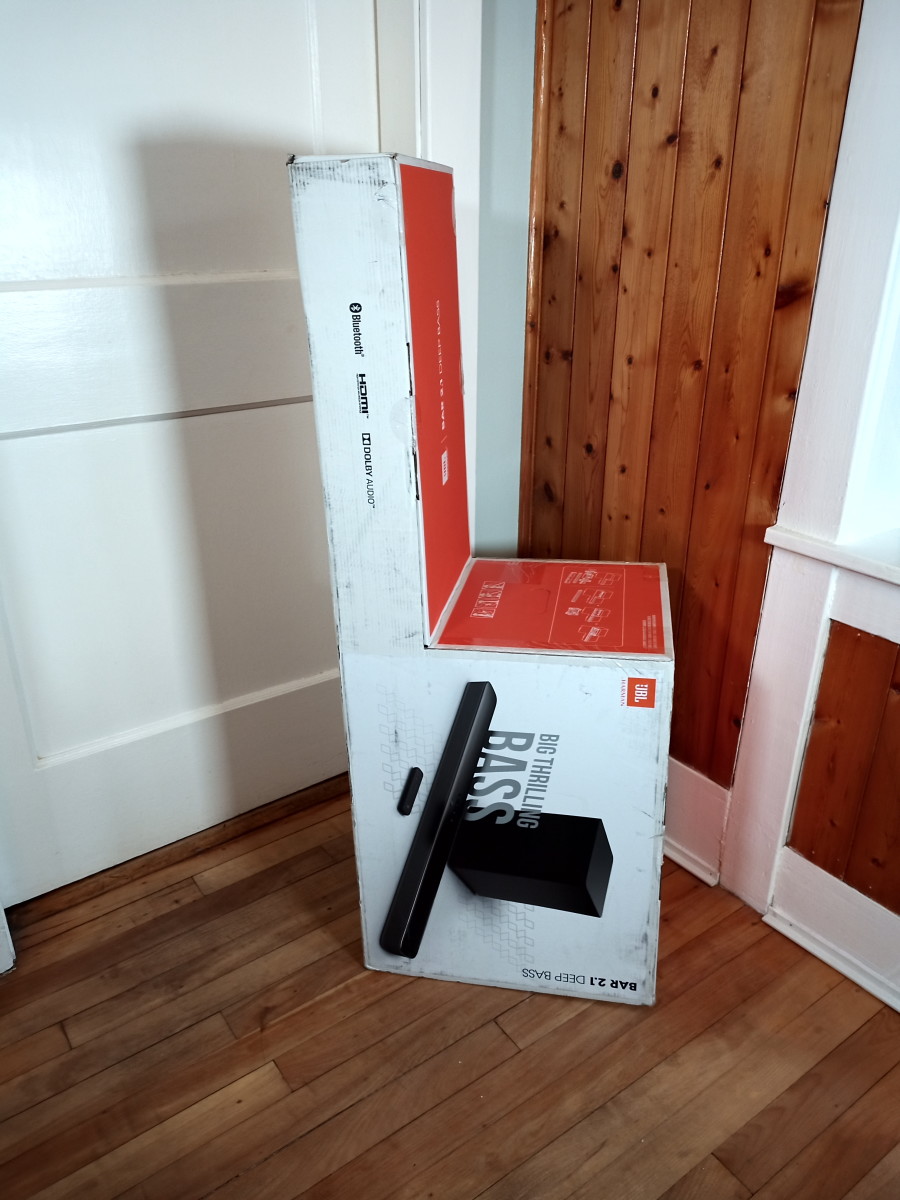Walter Shillington An inexpensive Bluetooth-capable soundbar fixed the problem. The new Bomaker speaker system sounded better and, with five times as much power, proved loud enough to compensate for the background noise. Two months later, thanks to a rare lottery win, there was an extra $300.00 in cash burning a hole in my pocket. Not one to waste money by sticking in a bank, I took a close look at the Bomaker soundbar. It worked fine, but this device failed to provide the theater-quality sound that goes so well with a projector. Perhaps it was time for an upgrade. Although the higher-end soundbars were outrageously expensive, there were a couple of enticing sound systems within my reach. One such device from Vizio featured 5.1 surround sound. The second option was a JBL soundbar that included a powerful 200-watt, 6.5-inch subwoofer. Sadly, in this price range, you must choose between great bass or surround sound. I chose bass.
Description
This 2.1 channel system includes a soundbar, subwoofer, and remote control. The soundbar dimensions are 38 x 2.28 x 3.35 inches. The subwoofer’s enclosure is 8.9 inches deep, 8.9 inches wide, and 14.6 inches high. JBL has rated the soundbar at 300 watts of power with two 50-watt outputs from the main unit and 200 watts from the subwoofer. This system offers Bluetooth 4.2, USB playback, and supports Dolby Digital content. Note that USB playback is only available with US models. The soundbar’s Inputs/outputs consist of the power connector, an optical input, a USB port, and two v1.4 HDMI ports. One of these HMDI ports is an input, and the other is an output with ARC functionality. Each of the soundbar channels consists of two 2.25-inch race-track drivers along with a single 1-inch tweeter. Bass is provided by a separately enclosed wireless 6.5-inch, down-firing subwoofer. This system ships with a remote that works well but features a relatively meager selection of settings.
Specifications
Brand: JBL Name: JBL Bar 2.1 Deep Bass Soundbar with Wireless Subwoofer Total rated power: 300 watts Soundbar dimensions: 96.5 x 5.8 x 8.5 centimeters (38 x 2.28 x 3.35-inches) Soundbar speakers: Four 5.7-millimeter (2.25 inch) race-track drivers and two 2.5-centimeter (1 inch) tweeters Soundbar power: 2 x 50 watts Subwoofer dimensions: 22.6 x 22.6 x 37 centimeters (8.9 x 8.9 x 14.6-inches) Subwoofer speaker: 6.5-inch down-firing Subwoofer power: 200 watts Inputs: Optical, HDMI, USB, and Bluetooth Dolby decoding: Yes DTS decoding: No Features: Adjustable volume, smart, and bass WiFi capable: No Bluetooth: Version 4.2 Frequency Response: 40Hz~20KHz Remote: Yes
The Manufacturer
Harman International Industries trademarks JBL. This company designs and manufactures a wide variety of speakers and headphones. Walter Shillington
Visual Appeal
Like the system it replaces, this JBL soundbar is long, low-slung, and colored gray. It features an easy-to-read display providing information pertaining to volume, input selection, and sound adjustments. I have placed the soundbar atop a small table that is centered below my projector screen. The boxy gray subwoofer sits alongside the table. Overall, this sound system fits nicely into the overall design of the room.
Connections
This soundbar can be connected using an optical cable, HMDI, or Bluetooth. It may be configured for use with HDMI ARC.
Bluetooth
I connected the soundbar to power and switched to Bluetooth mode. The word ‘Bluetooth’ appeared on the display as the soundbar searched for a source. After powering up my projector, I selected its Bluetooth mode and waited as the device looked for a compatible speaker. Once it found the JBL soundbar, I selected the connect command. The soundbar promptly connected. From then on, every time I powered up both the soundbar and projector, they would search for each other automatically and then connect. I was worried that there would be a slight delay between video and audio, but they work in complete synchronism.
Sound Quality
The projector’s built-in speakers had sufficient volume at 75 percent, providing there was minimal background noise. Once I turned on my air conditioners and fans, even 95 percent volume proved inadequate. With five times the power output of the projector’s speakers, the Bomaker soundbar easily cuts through background noise. I usually set it at 60 percent, dropping the volume even lower when the fans are not required. My new JBL system can output about five times the power of the Bomaker, although two-thirds of that is directed from its subwoofer. I usually set the volume between 40 and 60 percent, sometimes increasing it further when watching an action-packed thriller. The remote allows me to choose between three different bass levels. When watching television or movies, I usually pick the strongest level of bass. It always sounds great. If I tune into VELO to watch a video, I adjust the bass level to match the music. Sadly, a selection of three different bass levels is not sufficient for those who use the JBL soundbar to listen to music. They should have included a fourth level somewhere between the second and third selection. What I really wanted to do was duplicate the type of sound you would hear at the cinema. This JBL soundbar gets me reasonably close. It lacks the immersive surround-sound experience I’d get in a theater, but it can reach very high volumes and perfectly replicate every thud, bang, and thump. If you like your bass, you will love this sound system.
Overall Impression
This system performs well when compared to other soundbars in its price range. While lacking surround sound, it has plenty of power, is easy to set up, and comes with a noticeably punchier subwoofer than its competition. If you are looking for a cinema-type experience but don’t have a large budget, the JBL Bar 2.1 Deep Bass Soundbar with Wireless Subwoofer is worth a close look. This content is accurate and true to the best of the author’s knowledge and is not meant to substitute for formal and individualized advice from a qualified professional. © 2021 Walter Shillington


















